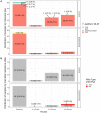Trial of Three Rounds of Mass Azithromycin Administration for Yaws Eradication
- PMID: 34986286
- PMCID: PMC7612200
- DOI: 10.1056/NEJMoa2109449
Trial of Three Rounds of Mass Azithromycin Administration for Yaws Eradication
Abstract
Background: Treponema pallidum subspecies pertenue causes yaws. Strategies to better control, eliminate, and eradicate yaws are needed.
Methods: In an open-label, cluster-randomized, community-based trial conducted in a yaws-endemic area of Papua New Guinea, we randomly assigned 38 wards (i.e., clusters) to receive one round of mass administration of azithromycin followed by two rounds of target treatment of active cases (control group) or three rounds of mass administration of azithromycin (experimental group); round 1 was administered at baseline, round 2 at 6 months, and round 3 at 12 months. The coprimary end points were the prevalence of active cases of yaws, confirmed by polymerase-chain-reaction assay, in the entire trial population and the prevalence of latent yaws, confirmed by serologic testing, in a subgroup of asymptomatic children 1 to 15 years of age; prevalences were measured at 18 months, and the between-group differences were calculated.
Results: Of the 38 wards, 19 were randomly assigned to the control group (30,438 persons) and 19 to the experimental group (26,238 persons). A total of 24,848 doses of azithromycin were administered in the control group (22,033 were given to the participants at round 1 and 207 and 2608 were given to the participants with yaws-like lesions and their contacts, respectively, at rounds 2 and 3 [combined]), and 59,852 doses were administered in the experimental group. At 18 months, the prevalence of active yaws had decreased from 0.46% (102 of 22,033 persons) at baseline to 0.16% (47 of 29,954 persons) in the control group and from 0.43% (87 of 20,331 persons) at baseline to 0.04% (10 of 25,987 persons) in the experimental group (relative risk adjusted for clustering, 4.08; 95% confidence interval [CI], 1.90 to 8.76). The prevalence of other infectious ulcers decreased to a similar extent in the two treatment groups. The prevalence of latent yaws at 18 months was 6.54% (95% CI, 5.00 to 8.08) among 994 children in the control group and 3.28% (95% CI, 2.14 to 4.42) among 945 children in the experimental group (relative risk adjusted for clustering and age, 2.03; 95% CI, 1.12 to 3.70). Three cases of yaws with resistance to macrolides were found in the experimental group.
Conclusions: The reduction in the community prevalence of yaws was greater with three rounds of mass administration of azithromycin at 6-month intervals than with one round of mass administration of azithromycin followed by two rounds of targeted treatment. Monitoring for the emergence and spread of antimicrobial resistance is needed. (Funded by Fundació "la Caixa" and others; ClinicalTrials.gov number, NCT03490123.).
Copyright © 2022 Massachusetts Medical Society.
Figures


References
-
- Mitja O, Asiedu K, Yaws Mabey D. Lancet. 2013;381(9868):763–73. - PubMed
-
- Mitjà O, Hays R, Ipai A, et al. Single-dose azithromycin versus benzathine benzylpenicillin for treatment of yaws in children in Papua New Guinea: An open-label, non-inferiority, randomised trial. Lancet. 2012;379(9813):342–7. - PubMed
-
- World Health Organization. [cited 2021 Feb 22];Summary Report of A Consultation on the Eradication of Yaws. 2012 43 [Internet]. (March 2012). Available from: https://www.who.int/yaws/resources/who_htm_ntd_idm_2012.2/en/
-
- World Health Organization. WHO. Eradication of yaws-the Morges Strategy. 2016. [cited 2021 Feb 22]. [Internet]. Available from: https://www.who.int/neglected_diseases/resources/who_wer8720/en/
Publication types
MeSH terms
Substances
Supplementary concepts
Associated data
Grants and funding
LinkOut - more resources
Full Text Sources
Other Literature Sources
Medical
